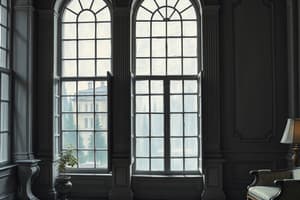Podcast
Questions and Answers
Qual das seguintes características NÃO é associada à arquitetura neoclássica?
Qual das seguintes características NÃO é associada à arquitetura neoclássica?
Qual é a principal influência da arquitetura neoclássica no design moderno?
Qual é a principal influência da arquitetura neoclássica no design moderno?
Qual arquiteto é conhecido por sua contribuição ao movimento neoclássico?
Qual arquiteto é conhecido por sua contribuição ao movimento neoclássico?
Qual destes edifícios é um exemplo proeminente da arquitetura neoclássica?
Qual destes edifícios é um exemplo proeminente da arquitetura neoclássica?
Signup and view all the answers
A arquitetura neoclássica é inspirada principalmente em quais estilos?
A arquitetura neoclássica é inspirada principalmente em quais estilos?
Signup and view all the answers
Qual das seguintes características é uma definição importante da arquitetura neoclássica?
Qual das seguintes características é uma definição importante da arquitetura neoclássica?
Signup and view all the answers
Qual arquiteto é conhecido por suas contribuições significativas ao movimento neoclássico, particularmente em designs decorativos?
Qual arquiteto é conhecido por suas contribuições significativas ao movimento neoclássico, particularmente em designs decorativos?
Signup and view all the answers
Como a arquitetura neoclássica se diferencia da arquitetura barroca?
Como a arquitetura neoclássica se diferencia da arquitetura barroca?
Signup and view all the answers
Quais são as ordens clássicas que são frequentemente utilizadas na arquitetura neoclássica?
Quais são as ordens clássicas que são frequentemente utilizadas na arquitetura neoclássica?
Signup and view all the answers
Qual é um dos impactos da arquitetura neoclássica no design moderno?
Qual é um dos impactos da arquitetura neoclássica no design moderno?
Signup and view all the answers
Qual é a característica mais notável das fachadas de edifícios neoclássicos?
Qual é a característica mais notável das fachadas de edifícios neoclássicos?
Signup and view all the answers
Como Thomas Jefferson contribuiu para a arquitetura neoclássica?
Como Thomas Jefferson contribuiu para a arquitetura neoclássica?
Signup and view all the answers
Qual das opções abaixo melhor descreve a estética da arquitetura neoclássica?
Qual das opções abaixo melhor descreve a estética da arquitetura neoclássica?
Signup and view all the answers
Study Notes
Neoclassical Architecture: Visionary Architects, Key Features, Modern Design Influence
- Neoclassical architecture emerged as a reaction against the perceived excesses of the Baroque and Rococo styles, emphasizing order, symmetry, and rationality.
- It drew inspiration from ancient Greek and Roman styles, particularly in its use of columns, pediments, and other classical motifs.
Key Characteristics
- Symmetry and Balance: Buildings feature symmetrical facades, meticulously balanced proportions, and harmonious arrangements of elements.
- Classical Orders: The use of classical architectural orders like Doric, Ionic, and Corinthian columns, entablatures, and pediments was a defining feature.
- Geometric Shapes: Emphasis on geometric shapes, such as rectangles, squares, and circles, contributed to the clear and orderly aesthetic.
- Simplicity and Restraint: Neoclassical architecture avoided the elaborate ornamentation of Baroque and Rococo styles, embracing simplicity and restraint in its design.
- Symmetry: Buildings are usually highly symmetrical, with a strong central focus and balanced elements on either side.
- Columns: Classical columns (Doric, Ionic, Corinthian) are commonly used in facades and interiors.
Influential Architects
- Robert Adam: A significant figure in the Neoclassical movement, particularly known for his exquisite decorative designs. His work incorporated subtle variations and elaborate ornament into the generally restrained neoclassical style.
- James Gibbs: Known for his graceful design and refined compositions, including the St. Martin-in-the-Fields church in London. Gibbs incorporated baroque elements within a refined neoclassical facade.
- Thomas Jefferson: While not solely a neoclassical architect, Jefferson's designs, like Monticello and the Virginia State Capitol, reflect strongly neoclassical principles blending them with American styles.
Influence on Modern Design
- Neoclassical principles of order, proportion, and symmetry continue to influence contemporary architecture and design.
- The emphasis on geometric forms and balanced compositions in many modern buildings reflects the enduring appeal of neoclassical design principles.
- The use of classical orders, although sometimes in a reinterpreted form, still appear in contemporary buildings to convey a sense of elegance and sophistication.
- The clean lines and restrained approach to ornament in neoclassical design can be seen in many modern architectural styles, specifically in the desire for an enduring, timeless quality.
- Principles of harmony, balance, and proportion in neoclassical design provide a foundation for principles of modern design and spatial planning.
Notable Buildings
- Many government buildings and public structures in Europe and the Americas were designed in the Neoclassical style, demonstrating its significance as a design language associated with authority and civic virtue.
Specific Examples and Case Studies
- The US Capitol Building in Washington DC: A prime example of Neoclassical grandeur with its majestic proportions and intricate detailing.
- The Pantheon in Rome: An ancient Roman building that served as an important inspiration for neoclassical architects with its architectural design features.
- Other European capitals: During the 18th and 19th centuries, many European capitals built significant government and civic buildings using a neoclassical style.
Summary of Key Concepts
- Neoclassical architecture emphasized classical ideals of order, symmetry and rationality.
- Inspiration was drawn from classical Greek and Roman styles.
- Key characteristics included symmetry, balanced proportions, use of classical orders (columns, entablatures), geometric shapes, and restrained ornamentation.
- Architect's like Robert Adam, James Gibbs, and Thomas Jefferson, were influential in the movement.
- This style influenced modern design in its emphasis on order, proportion, and geometric forms.
Studying That Suits You
Use AI to generate personalized quizzes and flashcards to suit your learning preferences.
Description
A arquitetura neoclássica surgiu como uma reação contra os excessos dos estilos barroco e rococó, enfatizando a ordem e a simetria. Este estilo é caracterizado pelo uso de elementos clássicos, como colunas e pedimentos, além de formas geométricas que promovem uma estética clara e ordenada.




